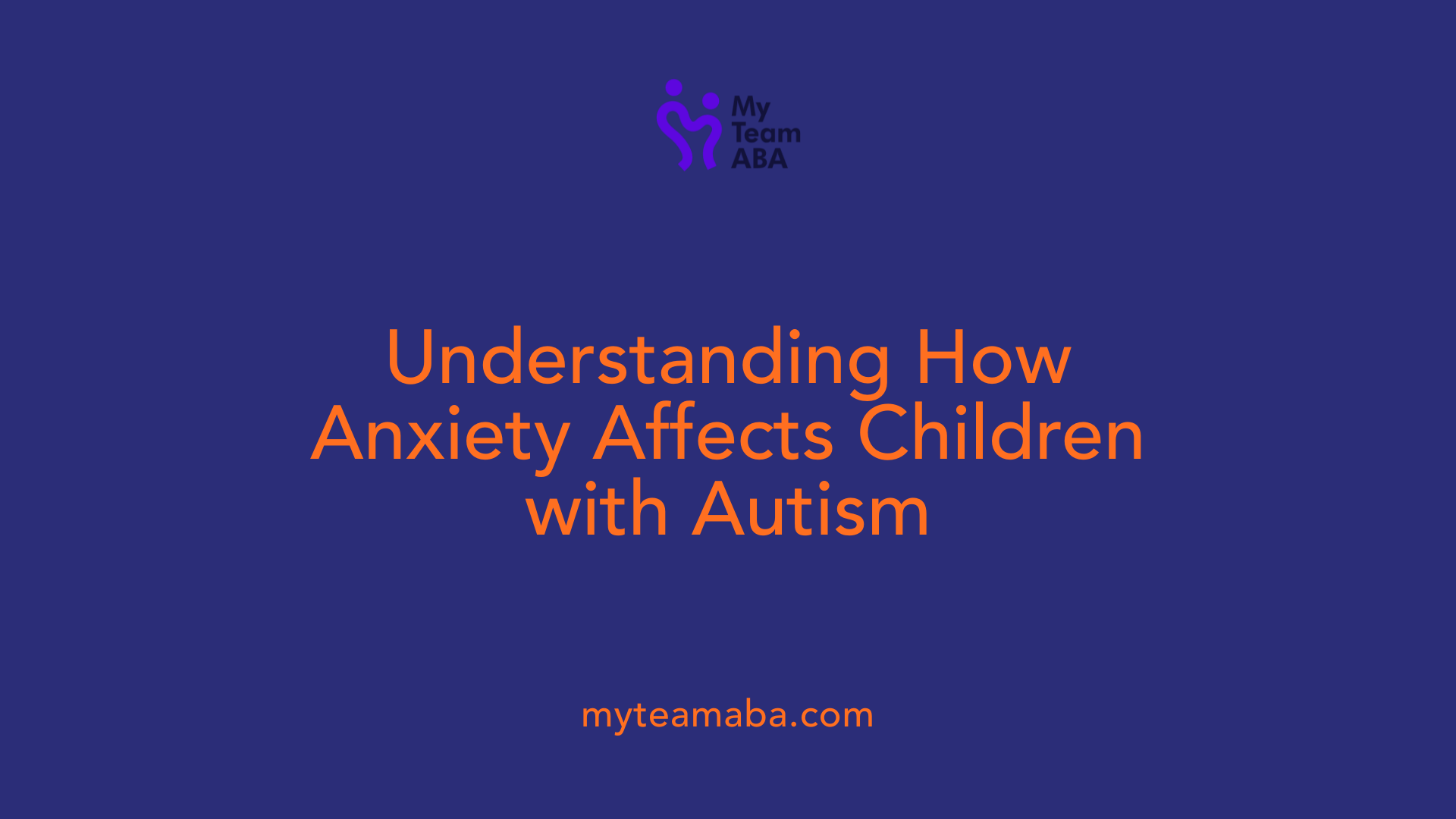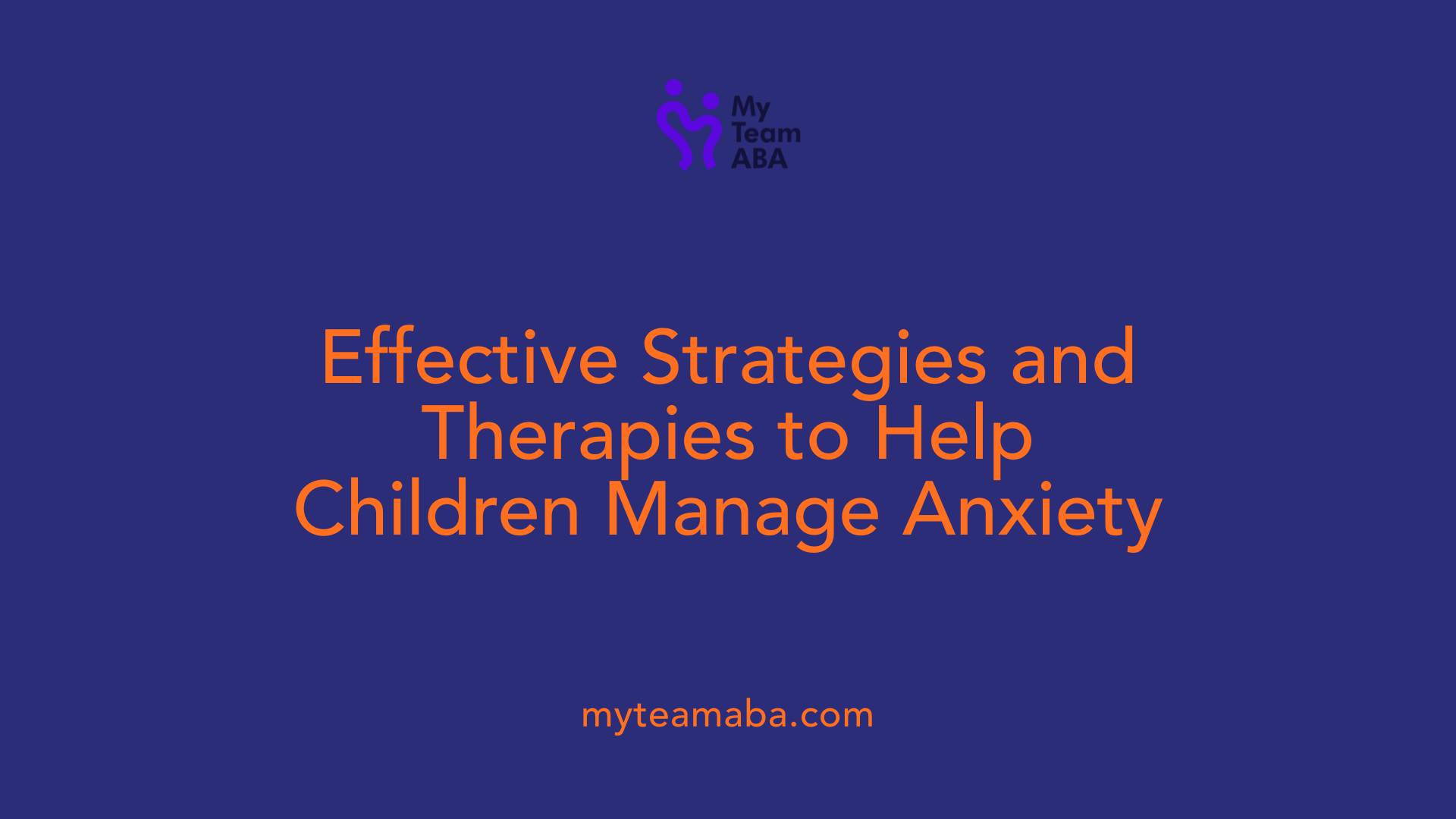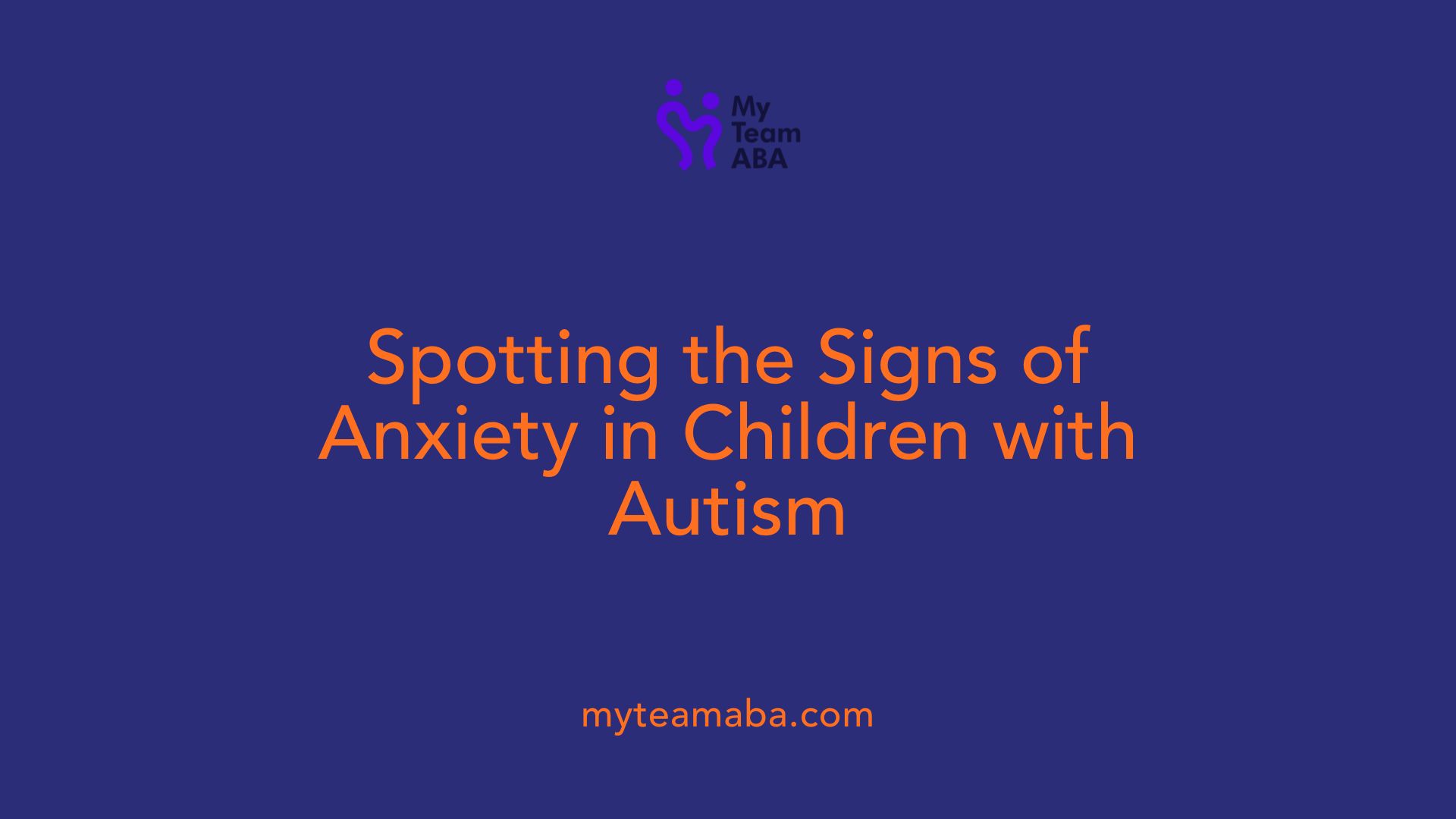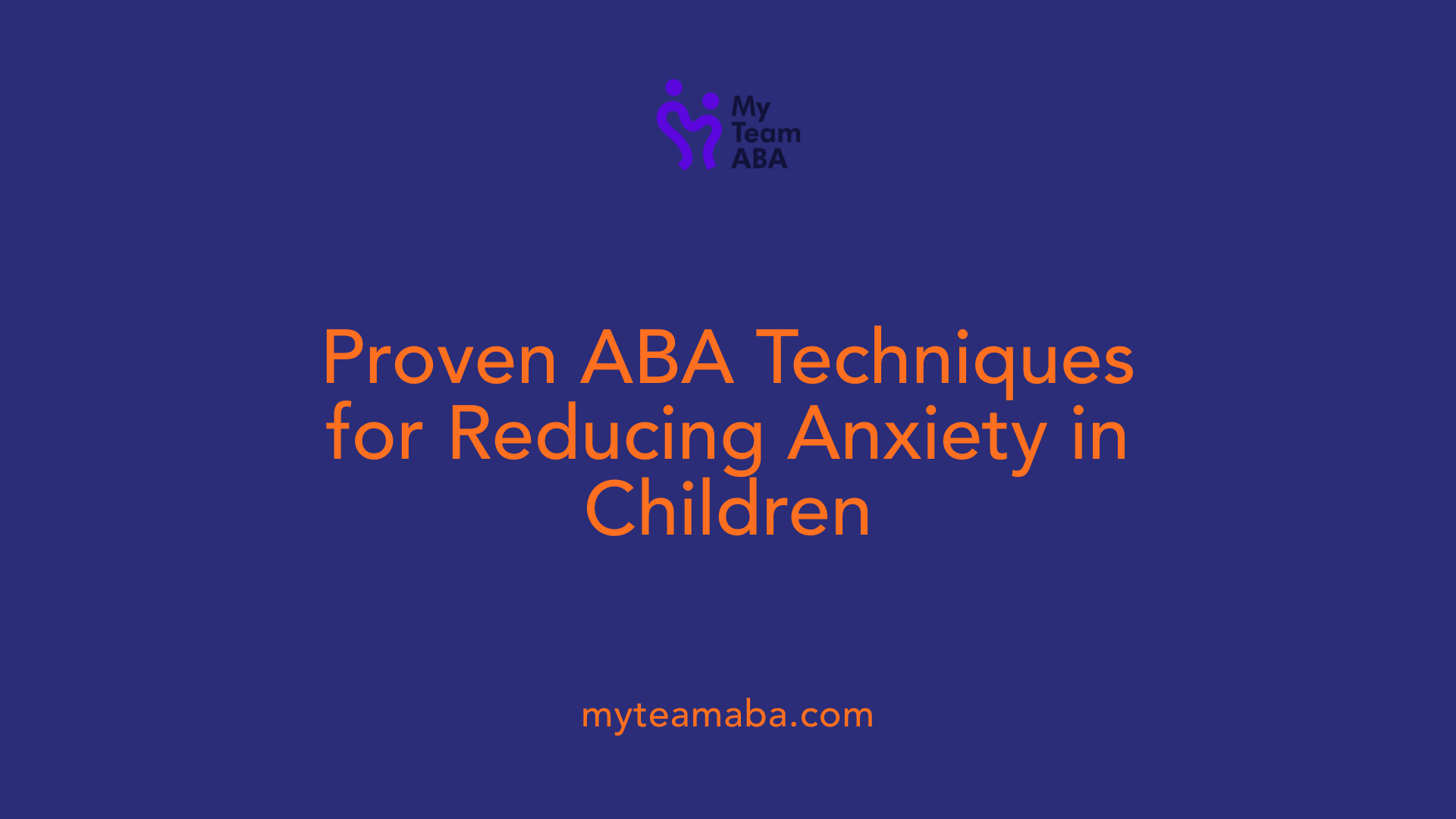How ABA Therapy Can Help Reduce Anxiety in Children with Autism
July 24, 2025
Harnessing ABA to Alleviate Anxiety in Children on the Spectrum

Understanding the Intersection of Autism and Anxiety
Children with autism often face a heightened prevalence of anxiety, with studies indicating that up to 40% of these children also have an anxiety disorder. This dual challenge can significantly impair their social interactions, learning, and overall well-being. Anxiety can amplify behavioral issues such as insistence on sameness, sensory sensitivities, and limited social engagement, creating a complex matrix that requires tailored intervention strategies. Recognizing and managing these symptoms early is crucial for improving quality of life and fostering resilience in children with autism.
Impact of Anxiety on Children with Autism

How does anxiety affect children with autism?
Children with autism frequently face anxiety that significantly impacts their daily lives. Up to 40% of children with autism are also diagnosed with an anxiety disorder. This co-occurrence can worsen behavioral challenges such as insisting on routines or showing sensory sensitivities.
Anxiety can also interfere with social interactions. Children may fear social situations or unfamiliar environments, leading to withdrawal or difficulty engaging with others. Often, children signal their distress through physical signs like trouble sleeping, meltdowns, or withdrawal behaviors.
The relationship between anxiety and autism is complex. While anxiety symptoms can sometimes appear independent of autism severity, they often make social participation and learning more difficult. Managing this overlap requires targeted strategies, including behavioral therapies such as Cognitive Behavioral Therapy (CBT), relaxation exercises, visual tools, and sometimes medication.
What are the physical and emotional signs of anxiety in children with autism?
Children may show various signs when anxious. These can include physical symptoms like increased heart rate, sweating, trouble sleeping, or physical agitation. Emotional signs often involve irritability, withdrawal, or repetitive behaviors like flapping or hand-fidgeting.
Recognizing these signs early allows caregivers to help children employ coping strategies promptly, reducing frustration and anxiety escalation.
Why is the coexistence of anxiety and ASD complex?
Dealing with both autism and anxiety can be challenging because their symptoms often reinforce each other. For example, sensory sensitivities common in autism can heighten feelings of anxiety, while anxiety can increase a child’s rigidity and repetitive behaviors.
Proper diagnosis and a nuanced approach are essential to address each condition effectively. Tailored interventions can significantly improve emotional well-being, social interactions, and overall quality of life for children facing this dual challenge.
Strategies and Therapies for Managing Anxiety
 Children with autism often face heightened levels of anxiety, which can intensify their condition and create additional challenges. Addressing this anxiety requires a combination of targeted strategies and therapeutic approaches tailored to each child's needs.
Children with autism often face heightened levels of anxiety, which can intensify their condition and create additional challenges. Addressing this anxiety requires a combination of targeted strategies and therapeutic approaches tailored to each child's needs.
One of the most well-established behavioral methods is Applied Behavior Analysis (ABA). ABA employs techniques such as discrete trial training, pivotal response training, and functional behavior assessments to understand and modify behaviors associated with anxiety. By breaking down desired behaviors into small, manageable steps and reinforcing positive responses, ABA helps children develop coping mechanisms and reduce anxiety symptoms.
Cognitive-behavioral therapy (CBT), adapted specifically for children with autism, focuses on psychoeducation, emotional regulation, and gradual exposure to anxiety-provoking situations. This therapy teaches children to recognize their feelings, develop relaxation skills, and challenge negative thoughts. Enhanced by visual supports like social stories, checklists, and schedules, CBT provides predictability and reduces uncertainty, which can often trigger anxiety.
In addition to these therapies, practical tools such as sensory integration activities and creating calming environments—like sensory rooms or personalized sensory kits—offer children a respite during moments of sensory overload or heightened anxiety. Techniques such as deep breathing, mindfulness, and progressive muscle relaxation are also effective in managing physical symptoms.
Family involvement plays a vital role in managing anxiety. Training caregivers to identify triggers, implement calming techniques, and maintain consistent routines ensures that strategies taught in therapy are reinforced at home. Social skills training further helps children navigate social interactions more confidently, reducing social anxiety.
While behavioral and psychological approaches form the foundation of anxiety management, pharmacological options like SSRIs may be recommended in some cases, ideally as supplements to psychotherapy. These medications can help regulate anxiety levels alongside ongoing behavioral interventions.
In summary, managing anxiety in children with autism involves a holistic approach combining ABA therapies, modified CBT techniques, visual supports, sensory tools, and active caregiver participation to foster resilience and emotional well-being.
Identifying Anxiety Signs in Children with Autism

How can parents and caregivers identify signs of anxiety in children with autism?
Parents and caregivers can become adept at recognizing anxiety by paying close attention to behavioral and physical cues. Behaviorally, children may display increased agitation, avoid certain situations, or become highly distressed during social interactions or when faced with unfamiliar environments.
An uptick in repetitive behaviors or sensory-seeking actions might also indicate underlying anxiety. Sleep and eating difficulties, mood swings, irritability, and withdrawal from social engagement are additional warning signs.
Physically, children may show signs such as a rapid heartbeat, shaking, sweating, or a sensation of feeling sick. Noticing regressions in self-regulation, more frequent meltdowns, or avoidance behaviors further supports prompt detection.
Monitoring these symptoms consistently and noting what triggers them—like routine changes or noisy environments—allows for early intervention. Recognizing these signs early can be instrumental in guiding appropriate support and reducing anxiety’s impact on children with autism.
ABA Techniques to Reduce Anxiety

What techniques are used in ABA therapy to reduce anxiety?
Applied Behavior Analysis (ABA) offers various strategies tailored to help children with autism manage and decrease anxiety. One of the primary techniques is gradual exposure, where children are slowly introduced to anxiety-provoking stimuli in a controlled setting, a process known as systematic desensitization. This approach allows kids to build confidence and reduce fear responses over time.
Creating a structured and predictable environment is vital. Using visual aids like social stories, checklists, and schedules helps children understand what to expect, which lowers uncertainty and stress. Visual supports also serve as cues for calming techniques and appropriate responses.
Behavior modeling is another core method, where children observe and imitate desired behaviors, such as calming activities or social interactions. Teaching relaxation and mindfulness strategies like deep breathing, progressive muscle relaxation, and comforting activities are integrated into sessions. These techniques help children manage physical symptoms of anxiety.
Social skills training is incorporated to improve interactions with peers and adults, reducing social anxiety. This involves role-playing, practicing greetings, and managing difficult social situations.
Positive reinforcement plays a crucial role in ABA, encouraging children to exhibit calm behaviors and effective coping mechanisms. When children succeed in using coping skills, they are rewarded, which boosts self-confidence and promotes retention of these behaviors.
Finally, ABA interventions are highly personalized. Behavior analysts conduct assessments to identify each child's specific triggers and design tailored plans. This individualized approach ensures the therapy directly targets areas of need, making it more effective.
When combined with other therapies, such as cognitive-behavioral therapy, ABA can significantly enhance anxiety management, leading to improved emotional well-being and better integration into daily life.
The Effectiveness of ABA in Anxiety Reduction
What are the benefits and effectiveness of ABA therapy for reducing anxiety in children with autism?
Research shows that applied behavior analysis (ABA) is a proven, evidence-based way to help children with autism manage anxiety. Through structured interventions, ABA teaches children to identify their triggers and develop healthier responses.
One significant advantage of ABA is its focus on creating personalized plans based on detailed assessments. These plans often combine elements from cognitive-behavioral therapy (CBT) and include techniques like systematic desensitization, visual supports, and social skills training.
All strategies are tailored to each child's needs, helping them learn coping skills and increase independence in anxiety-provoking situations. Over time, children not only reduce anxious behaviors but also improve in social skills and daily functioning.
The continuous tracking of progress using data allows therapists to adjust interventions and ensure that children are effectively learning to handle their fears. Ultimately, ABA's comprehensive approach fosters lasting improvements, supporting children to navigate their environment with confidence.
ABA in Early Intervention for Anxiety
Why is early diagnosis and intervention important for children with autism and anxiety?
Early diagnosis of autism and associated anxiety disorders allows for timely intervention, which can significantly improve long-term outcomes. When treated early, children can develop essential coping skills, improve social interactions, and reduce behavioral challenges. Intervening early can prevent the escalation of anxiety symptoms and help children navigate social and sensory situations more effectively.
How does ABA therapy help develop coping skills in children with autism?
Applied Behavior Analysis (ABA) in early intervention is tailored to meet each child's unique needs. It focuses on identifying specific triggers of anxiety through detailed behavior assessments. Using techniques like systematic desensitization and gradual exposure, ABA helps children confront fears in controlled steps. Reinforcement strategies encourage positive behaviors, teaching children ways to self-regulate and manage anxiety. The therapy also emphasizes teaching functional skills such as relaxation techniques, social skills, and routine adaptation.
What are the long-term benefits of starting ABA early?
Starting ABA therapy early can lead to lasting improvements in behavior, communication, and emotional regulation. Children often show better adaptation to new situations and exhibit reduced anxiety over time. Early ABA intervention supports the development of independence and enhances participation in social and educational activities. This proactive approach can lessen the intensity of anxiety symptoms, leading to a better quality of life and increased confidence.
How is ABA integrated with other therapies?
ABA often works alongside other therapeutic approaches to enhance effectiveness. For children with high-functioning autism, combining ABA with modified cognitive-behavioral therapy (CBT), visual supports, and social skills training can address both behavioral and emotional challenges comprehensively. Family involvement is also crucial, reinforcing strategies at home and creating consistent routines. The integration of multiple therapies ensures a holistic approach to managing anxiety and supporting overall development.
| Aspect | Description | Advantage |
|---|---|---|
| Early diagnosis | Detecting autism and anxiety early | Enables timely intervention |
| Individualized ABA plans | Tailored interventions based on behavior assessments | Addresses specific triggers and needs |
| Coping skills development | Teaching relaxation, social, and self-regulation skills | Empowers children to manage anxiety independently |
| Long-term benefits | Improved social participation and reduced anxiety | Enhances overall well-being and independence |
| Multimodal approach | Combining ABA with other therapies | Provides comprehensive support |
Overall, ABA’s structured and adaptive approach makes it an effective early intervention for children with autism and anxiety, fostering resilience and emotional health from a young age.
Historical Context and Ethical Considerations of ABA
What is the history, methods, and controversies surrounding ABA therapy in the context of anxiety management?
Applied Behavior Analysis (ABA) therapy has a long history dating back to the 1960s. It was pioneered by researchers like Ivar Lovaas, who developed techniques rooted in behavioral psychology. Initially, ABA focused heavily on structured and intensive interventions such as Discrete Trial Training, which aimed to teach specific skills through repetition and reinforcement.
In its early days, some ABA procedures included aversive techniques, such as electric shocks, intended to suppress unwanted behaviors. These methods sparked significant ethical debates within the autism community and the broader public, highlighting concerns over dignity and human rights.
Over the decades, ABA has shifted towards more naturalistic and child-centered approaches. Modern practices emphasize engaging children in play, fostering independence, and improving social participation. Techniques now prioritize positive reinforcement, skill development, and minimizing or eliminating the use of punishment.
Despite its evolution, ABA has faced ongoing controversy. Critics argue that some practices have historically been overly rigid or punitive, potentially causing emotional harm. Others question whether ABA's focus on conformity to neurotypical standards respects neurodiversity and individual differences.
Today, ABA remains one of the most researched and validated interventions for autism. It continuously incorporates ethical standards to ensure respectful, individualized care. The therapy now aims not only to reduce problematic behaviors but also to promote meaningful skills and positive quality of life outcomes for children.
This continual refinement demonstrates a commitment to ethically sound practices while harnessing ABA’s evidence-based foundation to support children with autism, including those managing anxiety.
Building a Path Forward with ABA and Supportive Strategies
Applying ABA therapy within a comprehensive, individualized framework offers a promising avenue for reducing anxiety in children with autism. When combined with visual supports, sensory tools, relaxation techniques, and parental involvement, ABA's evidence-based methods can foster resilience, independence, and emotional well-being. Critical to success is ethical practice and ongoing collaboration among therapists, families, and children, ensuring interventions respect neurodiversity and support each child's unique journey towards managing anxiety and thriving in their environment.
References
- Strategies for Managing Anxiety in Children With Autism
- The Role of ABA Therapy in Managing Anxiety
- Applied Behavior Analysis for Reducing Anxiety in Children
- Using ABA Therapy to Help Children with Autism Manage Anxiety
- The Controversy Around ABA - Child Mind Institute
- Can ABA Therapy Help with Anxiety?
- Is ABA Therapy Stressful? How Parents Can Manage Challenges
- treatment of anxiety in individuals with autism spectrum disorders
- Strategies for Managing Anxiety in Children With Autism
